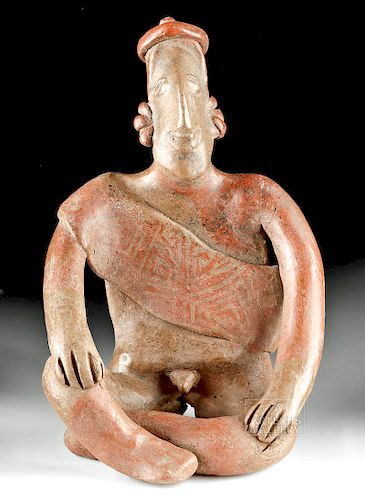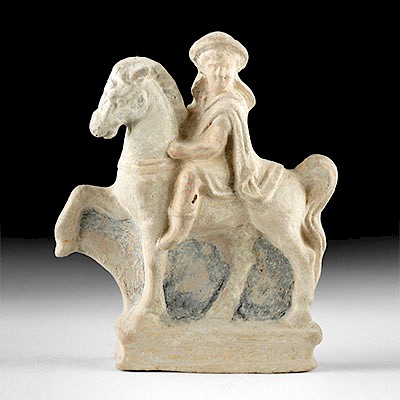Fine Jalisco Pottery Seated Male Figure
Lot 126
About Seller
Artemis Fine Arts
686 S Taylor Ave, Ste 106
Louisville, CO 80027
United States
Selling antiquities, ancient and ethnographic art online since 1993, Artemis Gallery specializes in Classical Antiquities (Egyptian, Greek, Roman, Near Eastern), Asian, Pre-Columbian, African / Tribal / Oceanographic art. Our extensive inventory includes pottery, stone, metal, wood, glass and textil...Read more
Estimate:
$1,500 - $2,000
Absentee vs Live bid
Two ways to bid:
- Leave a max absentee bid and the platform will bid on your behalf up to your maximum bid during the live auction.
- Bid live during the auction and your bids will be submitted real-time to the auctioneer.
Bid Increments
| Price | Bid Increment |
|---|---|
| $0 | $25 |
| $300 | $50 |
| $1,000 | $100 |
| $2,000 | $250 |
| $5,000 | $500 |
| $10,000 | $1,000 |
| $20,000 | $2,500 |
| $50,000 | $5,000 |
| $100,000 | $10,000 |
| $200,000 | $20,000 |
About Auction
By Artemis Fine Arts
May 9, 2019
Set Reminder
2019-05-09 10:00:00
2019-05-09 10:00:00
America/New_York
Bidsquare
Bidsquare : Ancient | Asian | Ethnographic
https://www.bidsquare.com/auctions/artemis-gallery/ancient-asian-ethnographic-4110
Featuring classical antiquities, ancient and ethnographic art from cultures encompassing the globe. All legally acquired, legal to sell. Satisfaction guaranteed. Convenient in-house shipping. Artemis Fine Arts info@artemisfinearts.com
Featuring classical antiquities, ancient and ethnographic art from cultures encompassing the globe. All legally acquired, legal to sell. Satisfaction guaranteed. Convenient in-house shipping. Artemis Fine Arts info@artemisfinearts.com
- Lot Description
Pre-Columbian, West Mexico, Jalisco, ca. 300 BCE to 300 CE. A hand-built and highly-burnished male figure presented with deep red slip atop a pale-orange ground. The figure sits with crossed legs and delineated genitalia, holds both sinuous arms to his knees, and wears a broad sash adorned with elaborate linear motifs across his broad chest. His characteristically-elongated head boasts coffee-bean-shaped eyes, a prominent crested nose with a petite ring, a thin mouth, and a trio of earrings on each ear. The forehead bears a slight lateral groove and is wrapped with a simple head band. Size: 5.25" W x 7.875" H (13.3 cm x 20 cm)
Clay figures like this example are the only remains that we have today of this sophisticated and unique culture in West Mexico -- they made no above-ground monuments or sculptures, at least that we know of, which is in stark contrast to developments elsewhere in ancient Mesoamerica. Instead, they developed a widely-used method of burial known as shaft tombs.
The dead were buried down shafts - 3 to 20 meters deep - that were dug vertically or near vertically through tepetate, the volcanic tuff that makes up the geology of the region. The base of the shaft would open into one or more horizontal chambers with a low ceiling. These shafts were almost always dug beneath a dwelling, probably a family home, and seem to have been used as family mausoleums, housing the remains of many related individuals. Their tombs were their lasting works of art: skeletons arrayed radially with their feet positioned inward, and clay offerings, like this one, placed alongside the walls facing inward, near the skulls.
Provenance: ex-private Los Angeles, California, USA collection
All items legal to buy/sell under U.S. Statute covering cultural patrimony Code 2600, CHAPTER 14, and are guaranteed to be as described or your money back.
A Certificate of Authenticity will accompany all winning bids.
We ship worldwide and handle all shipping in-house for your convenience.
#145677Right arm and leg reattached with nearly-invisible restoration and resurfacing along break lines. Minor abrasions to limbs, body, and head, with fading to original pigmentation. Light earthen deposits and manganese blooms throughout.Condition
- Shipping Info
-
All shipping is handled in-house for your convenience. Your invoice from Artemis Gallery will include shipping calculation instructions. If in doubt, please inquire BEFORE bidding for estimated shipping costs for individual items.
-
- Buyer's Premium



 EUR
EUR CAD
CAD AUD
AUD GBP
GBP MXN
MXN HKD
HKD CNY
CNY MYR
MYR SEK
SEK SGD
SGD CHF
CHF THB
THB
















